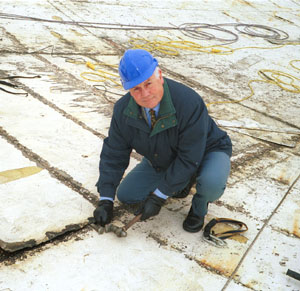The Lovell Telescope gets a Facelift
23 March 2001
Work has just begun to re-surface the world famous Lovell Telescope at the Jodrell Bank Observatory of the University of Manchester. On Thursday March 22nd, its Director, Professor Andrew Lyne, initiated an 18 month programme of work by ceremonially beginning to chisell off one of the old surface panels. New panels made from galvanized steel plates will be installed by a team from SHAL Engineering of Sheffield.
The new surface is a major part of an extensive upgrade to the Lovell Telescope jointly funded by a £2M grant from the Government and the Wellcome Foundation and which will be completed by the autumn of 2002. The new, higher precision, surface coupled with a sophisticated control system to be installed later in the year, will result in an expansion of the usable frequency range by a factor of four so allowing a wide range of new science to be carried out. As Professor Lyne pointed out "the upgrade to the Lovell Telescope will extend the capabilities and operational life of the telescope, keeping it at the forefront of astronomical research with as much promise and potential as when it was first built".
It is expected that the upgraded Lovell Telescope will allow Manchester and other UK astronomers to learn more about the life and death of stars, from their formation in the clouds of dust and gas in our Galaxy to the often cataclysmic explosions at the end of their life which often result in the ultra-compact objects we observe as Pulsars. Looking far beyond our own Galaxy, it will conduct a survey to discover radio galaxies and quasars formed soon after the birth of the Universe. However, as in the past, it is expected that the most important and exciting discoveries by the telescope will be those which are totally unpredictable.
The Lovell Telescope is also a major element of the UK's MERLIN high-resolution radio-imaging National Facility. The upgraded Lovell will more than double the sensitivity of MERLIN and will open up exciting new areas of astrophysical study at a resolution which exceeds that of the Hubble Space Telescope (HST) and is matched to that of the planned next generation of telescopes in other wavebands. The funding of an enhancement to MERLIN to provide even greater sensitivity via the optical-fibre connection of the telescopes is currently under consideration by UK science funding bodies.
FURTHER INFORMATION:
The University of Manchester's giant 76-metre (250ft) Lovell radio telescope at Jodrell Bank is probably the most famous working scientific instrument in the land and is widely regarded by the public as an icon of the very best achievements of British science and technology. For over 40 years, the telescope, still the third largest fully-steerable radio telescope in the world, has played a major role in astronomical research due to its large collecting area and great flexibility. Equipped with state-of-the-art receiver systems, the telescope is now 30 times more sensitive than when it was first built. In recent years it has played a leading role in many fields of astronomy, including the detection and study of a new population of pulsars and the discovery of the first gravitational lens. It is also currently attracting great public interest through its participation in the most sensitive search ever for signals from extra-terrestrial intelligence.
The upgrade package has four main elements, to be completed at a fraction of the cost (at least £30M) of building a new telescope of the same size and comparable performance:
1) New Reflecting Surface
The present surface panels are being replaced by new galvanized steel plates. Attachment is with self tapping screws to avoid thermal distortions of the type induced in the present surface by spot welding. Work will take place throughout the spring and summer of 2001 and 2002.
2) Precision Surface Adjustment
Using modern holographic profiling techniques, the new surface will be set to optimise the efficiency of the telescope and so allow operation at wavelengths down to 5 cm, at least four times shorter than at present.
3) New Telescope Control System
The present drive and control system will be replaced in the late summer of 2001 by state-of-the-art technology to increase the precision of the positional control. This will involve independent control of individual drive motors.
4)Refurbishment of the Track and Foundations
Remedial work on the surface layer of the foundations has been carried out to prevent water ingress and the outer rail tracks on which the telescope rotates have been relaid.
CONTACT DETAILS:
Professor Andrew Lyne, agl@jb.man.ac.uk
Professor Peter Wilkinson, pnw@jb.man.ac.uk
Ian Morison, im@jb.man.ac.uk
All at the Jodrell Bank Observatory, University of Manchester.
Phone: 01477 571321
FAX: 01477 571618
Click on the above images for high resolution copies.
An Image of the 76m Lovell Telescope can be found at: http://www.jb.man.ac.uk/research/seti/Lovell.jpg
Further details about the Lovell Telescope upgrade can be found at http://www.jb.man.ac.uk/tech/lovellupgrade/
An illustrated overview of the work of the Jodrell Bank Observatory can be seen on the World-Wide-Web at http://www.jb.man.ac.uk/
BACKGROUND INFORMATION:
MERLIN (Multi Element Radio Linked Interferometer Network) is one of the most powerful radio telescopes in the world. It is operated by the University of Manchester on behalf of the Particle Physics and Astronomy Research Council (PPARC) and is the radio astronomy cornerstone of the United Kingdom's astronomy programme. MERLIN is a sensitive network of 7 telescopes distributed over central England; several at and near Jodrell Bank in Cheshire, one at Knockin near the Welsh border, one at Defford in Worcestershire and the newest located just outside Cambridge. MERLIN produces radio images with the same level of detail as that achieved optically with NASA's Hubble Space Telescope.
More information can be found at:
http://www.jb.man.ac.uk/merlin
The Lovell telescope is regularly linked to telescopes in Europe and around the globe to make observations with the highest resolution in all astronomy. Using a technique known as Very Long Baseline Interferometry (VLBI), in which the signals from each telescope are recorded on large magnetic tapes and then replayed later on special purpose data processors, astronomers can synthesize a telescope with a diameter of up to 12,000 km. The Lovell Telescope's contribution to this research will be greatly enhanced, with the upgraded telescope able to play a significant role in the expansion of these activities into space. Major advances can be expected in the investigation of objects ranging from nearby stars in the Milky Way to the most distant galaxies and quasars. More details on the European VLBI Network (EVN) can be found at:
The Joint Infrastructure Fund (JIF) is a £750 million partnership for the improvement of University research infrastructure between the Wellcome Trust, the Office of Science and Technology and the Higher Education Funding Council for England. Details can be found on the Wellcome Trust website at:




